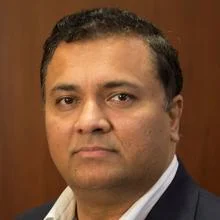Fighting employee burnout is a key priority for CIOs, especially as teams deal with the ongoing impact of the pandemic and embrace new hybrid ways of working. But IT leaders are not immune to the impacts of burnout. In order to truly help their employees manage work stress and find work-life balance, leaders have to start with themselves.
We asked CIOs who recently won the 2022 Houston CIO of the Year ORBIE Awards how they personally protect themselves from burnout. Read their responses for advice on how to maintain a healthy work-life blend while continually finding inspiration at work.
1. Connect with family, meditate, or learn something new

Vagesh Dave, Global VP & CIO, McDermott : “There are a few routines that I follow to renew and re-energize regularly. I am a big believer in human connections and the power of staying grounded in your roots. I spend time with family to recharge; I call and connect with either a distant family member or an old friend every week.
[ Looking for more burnout prevention strategies? Read 5 tips to prevent IT team burnout. ]
“Additionally, I find ways to engage in the local community and give back by volunteering. I also spend a lot of time reflecting and meditating each week – some of which happens on long bicycle rides along local trails and parks. It’s my way of getting closer to my inner self and decompressing.
“And finally, learning new things – reading, listening to podcasts, and webinars – allows me to exercise the creative and inquisitive side of my brain. All of these keep me grounded and recharged.”
2. Consider an hour of power or a dance-off

Rennu Varghese, VP & CIO, The Friedkin Group: “’E Pluribus Unum’ is the reality for CIOs today: Many different responsibilities in one role. In addition to navigating changes brought about by the pandemic, the demands on IT are accelerating as technology and humanity converge to change how we live and work. Acknowledge that burnout is a real risk and can creep up unless intentionally managed. You cannot conduct an orchestra from the chorus line.
“Prioritize yourself. It is not selfish; it’s an act of self-care. Set aside an ‘hour of power’ every day, first thing in the morning. During this hour, go analog and keep all digital distractions away. Protect that time fiercely and find an activity that nourishes your mind. For instance, learn something new and exciting, read some non-fiction that is energizing and inspiring, journal, or meditate. Find what works for you and do it every day.
“Get moving. A healthy mind needs a healthy body. Do something, anything, to get some physical activity into your day. If dancing to disco is your thing, turn up the volume and go for it. Posting it on TikTok is optional, and maybe not advisable.
“Stay connected. You are not alone – no matter what you’re going through, someone else has experienced it. Showing vulnerability is not a weakness, it is a strength. Build and nurture a close group of trusted advisors, preferably outside your company. Build relationships before you need them. Don’t be afraid to ask for help. They can help you work through challenges and provide an avenue to help others on this journey.”
3. Keep work out of your personal time

Amanda Hammel, SVP & CIO, Memorial Hermann Health System: “It can be challenging to protect our personal time in a work-first, 24-hour culture. But we all need breaks to focus on our health, family, friends, and wellbeing.
“At least once a year, I take a two-week vacation and remove my phone’s access to work email. I have a strong team of leaders I trust to deal with the day-to-day emergencies in my absence. They help me protect my personal time when I’m on vacation – and I, in turn, help protect their personal time when they are away from the office.
“The pandemic changed the ways we work and blurred some of the lines between work and personal time. I’ve taken a few steps to reclaim that separation. Most weekdays, I’ll block some time on my calendar for lunch so I won’t end up in eight hours of back-to-back Zoom meetings. When I work remotely, I also try to schedule a personal meeting on my calendar at 5 or 5:30 p.m. This separates the workday from the evening and gives me time to go for a walk or go to the gym. And on weekend mornings, I don’t log on or connect with work – that time is for myself, family, and church.
“I urge the members of my team to separate from work when they can. When we truly have a break, we come back refreshed and ready to give work our full energy.”
[ Learn how CIOs are speeding toward goals while preventing employee burnout in this report from Harvard Business Review Analytic Services: Maintaining Momentum on Digital Transformation. ]






